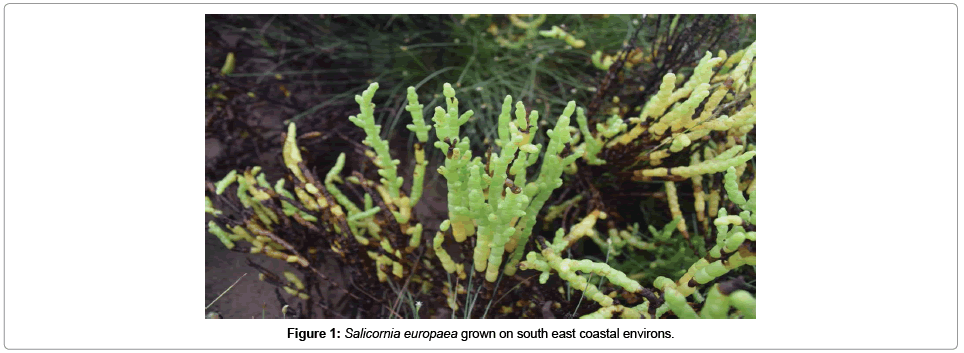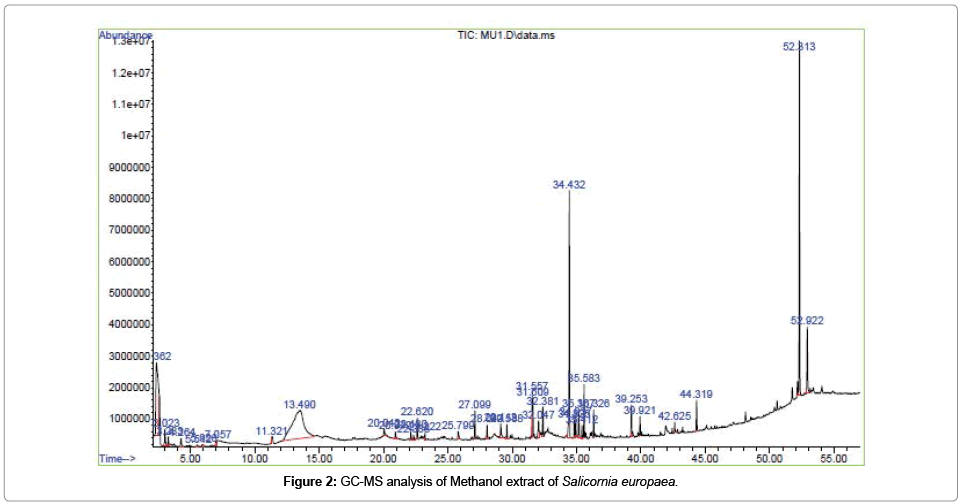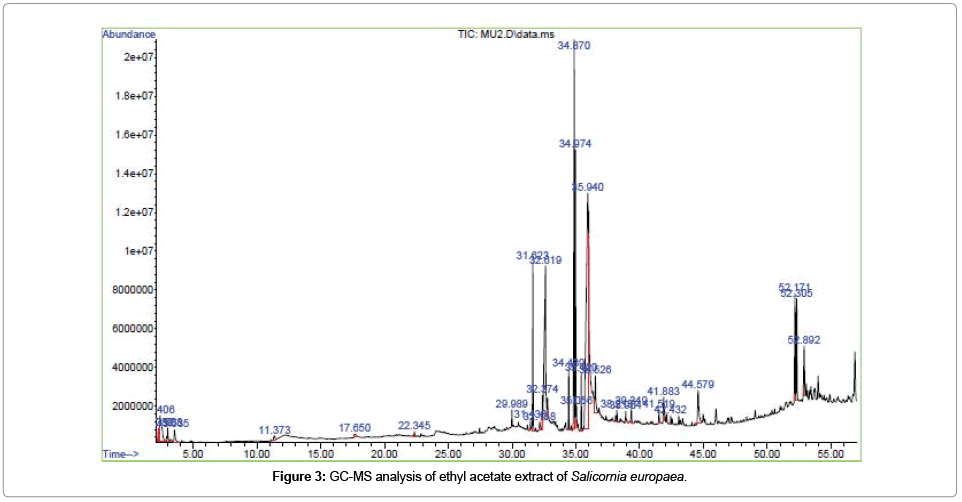Samuel P1*, Vijayakumar J1, Sudarmani DNP2, Rajeswari P1, Amirtharaj K1 and Deenathayalan R1
1Department of Biotechnology, Ayya Nadar Janaki Ammal College (Autonomous), Sivakasi, Tamil Nadu, India
2Department of Zoology (PG), Ayya Nadar Janaki Ammal College (Autonomous), Sivakasi, Tamil Nadu, India
*Corresponding Author:
Samuel P
Assistant Professor, Department of Biotechnology
Ayya Nadar Janaki Ammal College (Autonomous)
Sivakasi, Tamil Nadu, India
Tel: +919025559994
E-mail: drsamuelponpandian@rediffmail.com
Received Date: December 10, 2016; Accepted Date: December 28, 2016; Published Date: December 30, 2016
Citation: Samuel P, Vijayakumar J, Sudarmani DNP, Rajeswari P, Amirtharaj K, et al. (2016) Marine Halophyte: An Inviolated and Promising Source of Novel Lead Compounds against Deadly Diseases like Dengue and Breast Cancer. Int J Drug Dev & Res 8:014-017
Keywords
Halophyte; Salicornia europaea; NS5; ER; PDB; Drug targets; E-min/E-max
Introduction
Many infectious diseases are known to be treated with herbal remedies throughout the history of mankind. Even today, plant materials continue to play a major role as therapeutic remedies in many developing countries [1]. Marine halophytes are the specialized group of plants adopted for high saline conditions which include mangroves, seaweeds, sea grass, and blue green algae. They are also proven to have rich source of structurally diverse bioactive compounds with valuable pharmaceutical potential [2,3]. Breast cancer is the most common diagnosed malignancy in women worldwide (22%) and in India (18.5%) it ranks second to cervical cancer. The peak occurrence of breast cancer in developed countries is above the age of 50 whereas in India it is above the age of 40 (Population based cancer registries consolidated report (1990-96). India started National cancer registry program in 1981. Up to 2003 the program comprised of six population based cancer registry and one registry serving rural area covering the total population of 35.7 million (only 3.5% of the Indian total population) [4], and an increasing trend in incidence is reported from various registries of national cancer registry project and now India is a country with largest estimated number of breast cancer deaths worldwide (National cancer registry programme, Indian council of Medical Research, 2011. Dengue is caused by virus with potential fatal complications. The first clinical case report dates from 1789 of 1780 epidemic in Philadelphia is by Benjamin Rush, who coined the term “break bone fever”. Dengue viruses (DV) belong to family Flaviviridae and there are four serotypes of the virus referred to as DV-1, DV-2, DV-3 and DV-4. DV is a positive-stranded encapsulated RNA virus and is composed of three structural protein genes, which encode the nucleocapsid or core (C) protein, a membrane-associated (M) protein, an enveloped (E) glycoproteins and seven non-structural (NS) proteins. It is transmitted mainly by Aedes aegypti mosquito and also by Aedes albopictus. The WHO 2009 classification divides dengue fever into two groups: uncomplicated and severe though the 1997 WHO classification is still widely used. The key words “dengue/India” reflected 784 papers in PubMed.
Design and Methodology of the Study
The present study was carried out in the South east coastal environment of Thanjavur and pudhukottai district. The sampling spots are located on 10.20°N 79.24°E on the coast of the Bay of Bengal. The biomass (Figure 1) was collected carefully and brought to the laboratory for further phytochemical and insilico analysis. The fresh biomass was shade dried. About 8 grams of the dried material was extracted with methanol and ethyl acetate. The preliminary qualitative analysis for the phytochemicals present in the dried material was determined by Ref. [5]. The detailed nature of the type of phytoconstituents of individual extracts was determined by Gas Chromatography coupled with Mass Spectrometry (Model: Agilent 7890B) at the Sophisticated Analysis Instrumentation Facility (SAIF), Indian Institute of Technology, Madras. The instrument is enabled with the column called HP_5MS 5% Phenyl Methyl Silox- 60°C-325°C (325°C) and its dimension is 30 m × 250 μm × 0.25 μm. The injector temperature is 250°C and about 1 μL of the sample injected through auto sampler (G4513A). The flow rate of mobile phase (Helium Gas) is 1 mL/min and the scan range 40-700 m/z. Oven program 50°C for 2 min then ramp up to 300°C at 5°C/min, then 300°C hold for 5 min total run time 57 min. The GC-MS results of the extracts were illustrated (Figures 2 and 3). Selected protein target (2FOM) was downloaded from database Protein Data Bank (PDB: https://www.rcsb.org/pdb). (All water molecules were removed and on final stage hydrogen atoms were added to receptor molecule before docking. Totally 3 important phytocompounds available in the plant extract of Salicornia europaea were selected based on Lipinski rule of 5 described by Ref. [6]. Lipinski's rule of five also known as the Pfizer's rule of five or simply the Rule of five (RO5) is formulated to evaluate drug likeness or determine if a chemical compound with certain pharmacological or biological properties that would make it a likely orally active drug in humans. Structures of the phytochemicals were retrieved from PubChem saved as structure data format and *.pdb. All computational analysis was carried out on Windows 7 ultimate in HCL, Intel core 2 duo processors 4 GB RAM. The protein ligand interaction study was performed by Hex 6.3.

Figure 1: Salicornia europaea grown on south east coastal environs.

Figure 2: GC-MS analysis of Methanol extract of Salicornia europaea.

Figure 3: GC-MS analysis of ethyl acetate extract of Salicornia europaea.
Identification of phytoconstituents
Interpretation of mass spectrum of GC-MS was conducted using the database of National Institute Standard and Technology (NIST) having more than 62,000 patterns. The spectrum of the known component was compared with the spectrum of the known components stored in the NIST library. The name, molecular weight and structure of the components of the test materials were ascertained.
Results and Discussion
Edison [7] reported the Methanol and ethyl acetate extracts of Salicornia brachiata another halophyte member has showed significant radical scavenging activity and the free radicals are responsible for many physiological dysfunction and diseases [8,9]. Similarly, in the present study the methanol and ethyl acetate fractions of Salicornia europaea showed diversified nature of chemical leads with complex structures. The present study also confirms the presence of Flavonoids, tannins and saponins in ethyl acetate extract and Tannins, saponins and Coumarins in methanol extract could be the reason behind antioxidant properties of the members of this family [10]. Bibhu et al. [11] reported the antimicrobial nature of ethanolic extracts of Salicornia brachiata and the presence of two chromone derivatives namely 7-0-β-D-glucopyranosyl-6-methoxychromone and 7-Hydroxy-6- methoxychromone.
The present analysis on Salicornia europaea exhibit different chemical profile. It contains compounds like phthalate, palmitate, Sitosterol respectively. Havilah et al. [12] reported its promising antibacterial activity against fish pathogens. Hence the preliminary investigation on chemical diversity and biological activities of Salicornia europaea correlates with results reported by above said ones.
The following ligands were chosen to perform insilico docking studies with NS5 protease dengue virus receptor and Estrogen Receptor (ER) protein for breast cancer development. Ribavirin, Cidofovir and Viramidine were maintained as positive control for NS5 and Raloxifene, Toremifene and Toremifene analogs were maintained as positive control for ER protein docking studies. The results were tabulated (Table 1). Virupakshaiah [13], carried out docking studies of secondary metabolites like Gymnastatin G, Epoxyphomalin A, Conidiogenone C, Ustusorane E, Peribysin H, Chaetomugilin I and Aspergiolide B isolated from marine fungi for cancer study. The docking scores strongly revealed that the three potent compounds derived from marine halophyte has maximum docking score when compared to the standard positive controls used in the study. Thus the study confirms that organisms from marine environment showed diversified activities and contain unexploited metabolites.
| S No |
Compound name |
E-min/E-max values of ligands against
NS5 receptor |
E-min/E-max values of ligands against
ER receptor |
Positive controls for ER protein docking |
| E-min value |
E-max value |
E-min value |
E-max value |
Raloxifene** |
| 1. |
2,2,4-Trimethyl-1,2-dihydroquinoline |
-159.49 |
-125.47 |
-160.27 |
-124.96 |
| 2. |
*Ribavirin |
-8.333843 |
-46.108451 |
-97.0 |
-158.37 |
| 3. |
2-Pentadecanone, 6,10,14-trimethyl- |
-206.25 |
-170.80 |
-216.25 |
-120.80 |
Toremifene** |
| 4. |
*Cidofovir |
-8.146033 |
-51.785644 |
- 34.0 |
- 108.0 |
| 5. |
Dodecane, 4,6-dimethyl |
-186.61 |
-147.39 |
-187.45 |
-146.10 |
Toremifene analog** |
| 6. |
*Viramidine |
-6.920761 |
-38.608061 |
-49.0 |
-126.34 |
(*Positive control for NS5 receptor/**Positive control for ER protein)
Table 1: E-min/E-max values exhibited by drug leads against NS5 and ER receptors.
Acknowledgements
The corresponding author takes this opportunity to thank The Management and The Principal of Ayya Nadar Janaki Ammal College (Autonomous), Sivakasi for providing extensive laboratory support with advanced instruments for phytochemical and insilico studies.
Conflict of Interest
Conflict of Interest – Nil.
17948
References
- OdyP (1993) The complete medicinal Herbal. New York Dorling Kindesley Limited 132: 170-170.
- Ravikumar SL, Anburajan G,Ramanathan N(2002) Screening of seaweed extracts against antibiotic resistant post-operative infectious pathogens. Seaweed Res UtlnAssoc1: 95-99.
- Mayer AMS, Hamann MT (2002) Marine pharmacology in 1999: Compounds with antibacterial, anticoagulant, antifungal, antihelminthic, anti-inflammatory, antiplatelet, antiprotozoal and antiviral activities affecting the cardiovascular, endocrine, immune and nervous system, and other miscellaneous mechanisms of action. Comp Biotech Physiol Part C 132: 315-339.
- Siddiqi M, Sen U,Mondal SS,Patel DD,Yeole BB, et al. (2001) Cancer statistics from non-ICMR registries: Population based registries. CRAB (Cancer registry Abstract) Newsletter of the National. Cancer Registry Project of India, pp: 47-59.
- Harborne JB (1973) Phytochemical methods. Chapman and Hall Ltd.,London, UK, pp: 49-188.
- Lipinski CA, Lombardo F, Dominy BW, Feeney PJ (2001) Experimental and computational approaches to estimate solubility and permeability in drug discovery and development settings. AdvDrug Deliv Rev 46: 3-26.
- Edison DD, Karuppasamy R, Veerabahu RM (2013) Antioxidant activity, total phenolics and flavonoids of Salicornia brachiataroxb.leaf extracts (chenopodiaceae). World J of Pharmacy and Pharmaceutical Sciences 2: 353-366.
- Valko M, IzakovicM, Mazur M, Rhodes CJ, Telser J (2004) Role of oxygen radicals in DNA damage and cancer incidence. Molecular and Cellular Biochem266: 37-56.
- Valko M, Rhodes CJ, Moncol J, Izakovic M, Mazur M (2006) Free radicals, metals and antioxidants in oxidative stress-induced cancer. Chemico-Biological Interact160:1-40.
- Nandy S, Paul HS, Barman NR, Chakraborty B (2012) In vitro evaluation of antioxidant activity of Leucasplukenetii(Roth) Spreng. Asian J of Plant Sci and Res2:254-262.
- Bibhu PS, Panchanan G, Chakrapani P (2016) Salicornia brachiata: Isolation of 7-0-β-D-glucopyranosyl-6-ethoxychromone and 7-Hydroxy-6- methoxychromone from Ethanolic Plant Extract and Antimicrobial Studies. Int J sci edu and Res 4:5665-5673.
- Havilah K, Jeyasanta KI, Patterson Edward JK (2015) Antibacterial Activity from Marine Halophyte Salt Marsh Plant (Salicornia brachiata) against bacterial pathogens. Middle-East J of Scientific Res 23: 1262-1269.
- Virupakshaiah DBM (2014)In silico screening of secondary metabolites derived from marine fungi for anticancer study. J of AdvBioinfo App and Res 5:78-82.









